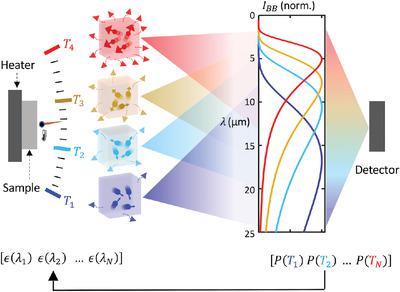当前位置:
X-MOL 学术
›
Laser Photonics Rev.
›
论文详情
Our official English website, www.x-mol.net, welcomes your
feedback! (Note: you will need to create a separate account there.)
Planck Spectroscopy
Laser & Photonics Reviews ( IF 9.8 ) Pub Date : 2021-08-29 , DOI: 10.1002/lpor.202100121 Yuzhe Xiao 1 , Chenghao Wan 1, 2 , Jad Salman 1 , Ian J. Maywar 1 , Jonathan King 1 , Alireza Shahsafi 1 , Mikhail A. Kats 1, 2, 3
Laser & Photonics Reviews ( IF 9.8 ) Pub Date : 2021-08-29 , DOI: 10.1002/lpor.202100121 Yuzhe Xiao 1 , Chenghao Wan 1, 2 , Jad Salman 1 , Ian J. Maywar 1 , Jonathan King 1 , Alireza Shahsafi 1 , Mikhail A. Kats 1, 2, 3
Affiliation

|
All spectrometers rely on some mechanism to achieve spectral selectivity; common examples include gratings, prisms, and interferometers with moving mirrors. A spectroscopic technique—here dubbed Planck spectroscopy—that measures the spectral emissivity of a surface using only a temperature-controlled stage and a detector, without any wavelength-selective optical components is experimentally demonstrated and validated. Planck spectroscopy involves the measurement of temperature-dependent thermally emitted power, where the spectral selectivity is realized via the temperature and wavelength dependence of Planck's law. Planck spectroscopy in the mid infrared, for wavelengths from 3 to 13 µm—limited primarily by the bandwidth of the detector—with resolution of ≈1 µm is experimentally demonstrated and validated. The minimalistic setup of Planck spectroscopy can be implemented using infrared cameras to achieve low-cost infrared hyperspectral imaging and imaging ellipsometry.
中文翻译:

普朗克光谱
所有光谱仪都依赖某种机制来实现光谱选择性;常见的例子包括光栅、棱镜和带有移动反射镜的干涉仪。一种光谱技术——这里被称为普朗克光谱——仅使用温度控制平台和检测器测量表面的光谱发射率,没有任何波长选择性光学组件,经过实验证明和验证。普朗克光谱涉及测量与温度相关的热发射功率,其中光谱选择性是通过普朗克定律的温度和波长依赖性来实现的。中红外普朗克光谱对于 3 到 13 µm 的波长(主要受探测器带宽的限制)具有 ≈1 µm 的分辨率已通过实验证明和验证。
更新日期:2021-10-19
中文翻译:

普朗克光谱
所有光谱仪都依赖某种机制来实现光谱选择性;常见的例子包括光栅、棱镜和带有移动反射镜的干涉仪。一种光谱技术——这里被称为普朗克光谱——仅使用温度控制平台和检测器测量表面的光谱发射率,没有任何波长选择性光学组件,经过实验证明和验证。普朗克光谱涉及测量与温度相关的热发射功率,其中光谱选择性是通过普朗克定律的温度和波长依赖性来实现的。中红外普朗克光谱对于 3 到 13 µm 的波长(主要受探测器带宽的限制)具有 ≈1 µm 的分辨率已通过实验证明和验证。











































 京公网安备 11010802027423号
京公网安备 11010802027423号